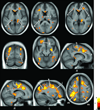Altered global and regional brain mean diffusivity in patients with obstructive sleep apnea
- PMID: 22715089
- PMCID: PMC3418429
- DOI: 10.1002/jnr.23083
Altered global and regional brain mean diffusivity in patients with obstructive sleep apnea
Abstract
Obstructive sleep apnea (OSA) is a common and progressive disorder accompanied by severe cardiovascular and neuropsychological sequelae, presumably induced by brain injury resulting from the intermittent hypoxia and cardiovascular processes accompanying the syndrome. However, whether the predominant brain tissue pathology is acute or chronic in newly-diagnosed, untreated OSA subjects is unclear; this assessment is essential for revealing pathological processes. Diffusion tensor imaging (DTI)-based mean diffusivity (MD) procedures can detect and differentiate acute from chronic pathology and may be useful to reveal processes in the condition. We collected four DTI series from 23 newly-diagnosed, treatment-naïve OSA and 23 control subjects, using a 3.0-Tesla magnetic resonance imaging scanner. Mean diffusivity maps were calculated from each series, realigned, averaged, normalized to a common space, and smoothed. Global brain MD values for each subject were calculated using normalized MD maps and a global brain mask. Mean global brain MD values and smoothed MD maps were compared between groups by using analysis of covariance (covariate: age). Mean global brain MD values were significantly reduced in OSA compared with controls (P = 0.01). Multiple brain sites in OSA, including medullary, cerebellar, basal ganglia, prefrontal and frontal, limbic, insular, cingulum bundle, external capsule, corpus callosum, temporal, occipital, and corona radiata regions showed reduced regional MD values compared with controls. The results suggest that global brain MD values are significantly reduced in OSA, with certain regional sites especially affected, presumably a consequence of axonal, glial, and other cell changes in those areas. The findings likely represent acute pathological processes in newly-diagnosed OSA subjects.
Copyright © 2012 Wiley Periodicals, Inc.
Conflict of interest statement
Figures


Similar articles
-
Global and Regional Brain Non-Gaussian Diffusion Changes in Newly Diagnosed Patients with Obstructive Sleep Apnea.Sleep. 2016 Jan 1;39(1):51-7. doi: 10.5665/sleep.5316. Sleep. 2016. PMID: 26285005 Free PMC article.
-
Abnormal myelin and axonal integrity in recently diagnosed patients with obstructive sleep apnea.Sleep. 2014 Apr 1;37(4):723-32. doi: 10.5665/sleep.3578. Sleep. 2014. PMID: 24899761 Free PMC article.
-
Brain structural changes in obstructive sleep apnea.Sleep. 2008 Jul;31(7):967-77. Sleep. 2008. PMID: 18652092 Free PMC article.
-
The role of diffusion tensor imaging and fractional anisotropy in the evaluation of patients with idiopathic normal pressure hydrocephalus: a literature review.Neurosurg Focus. 2016 Sep;41(3):E12. doi: 10.3171/2016.6.FOCUS16192. Neurosurg Focus. 2016. PMID: 27581308 Review.
-
White matter alterations in patients with obstructive sleep apnea: a systematic review of diffusion MRI studies.Sleep Med. 2020 Nov;75:236-245. doi: 10.1016/j.sleep.2020.06.024. Epub 2020 Jun 29. Sleep Med. 2020. PMID: 32861061
Cited by
-
Selective microstructural integrity impairments of the anterior corpus callosum are associated with cognitive deficits in obstructive sleep apnea.Brain Behav. 2019 Dec;9(12):e01482. doi: 10.1002/brb3.1482. Epub 2019 Nov 20. Brain Behav. 2019. PMID: 31749327 Free PMC article.
-
Functional comorbidities and brain tissue changes before and after lung transplant in adults.Front Cell Neurosci. 2022 Dec 2;16:1015568. doi: 10.3389/fncel.2022.1015568. eCollection 2022. Front Cell Neurosci. 2022. PMID: 36531134 Free PMC article.
-
Functional organization of the insula in men and women with obstructive sleep apnea during Valsalva.Sleep. 2021 Jan 21;44(1):zsaa124. doi: 10.1093/sleep/zsaa124. Sleep. 2021. PMID: 32592491 Free PMC article.
-
Obstructive sleep apnea and cortical thickness in females and males.PLoS One. 2018 Mar 6;13(3):e0193854. doi: 10.1371/journal.pone.0193854. eCollection 2018. PLoS One. 2018. PMID: 29509806 Free PMC article.
-
White matter integrity in obstructive sleep apnea before and after treatment.Sleep. 2014 Sep 1;37(9):1465-75. doi: 10.5665/sleep.3994. Sleep. 2014. PMID: 25142557 Free PMC article. Clinical Trial.
References
-
- Aggleton JP, Vann SD, Saunders RC. Projections from the hippocampal region to the mammillary bodies in macaque monkeys. Eur J Neurosci. 2005;22(10):2519–2530. - PubMed
-
- Ahlhelm F, Schneider G, Backens M, Reith W, Hagen T. Time course of the apparent diffusion coefficient after cerebral infarction. Eur Radiol. 2002;12(9):2322–2329. - PubMed
-
- Ashburner J, Friston KJ. Unified segmentation. NeuroImage. 2005;26(3):839–851. - PubMed
Publication types
MeSH terms
Grants and funding
LinkOut - more resources
Full Text Sources
Medical

